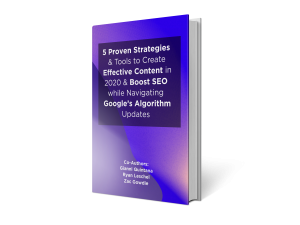How To Create Effective Content in 2020 and Boost Your SEO
“Is your content driving the right type of traffic and potential leads to your website?”
If you answered, “I don’t know” or “I’m not really sure how effective our content is”, then this is for you.
Each year, Google makes hundreds of changes to search. In 2018, they reported an incredible 3,234 updates — an average of almost 9 per day, and more than 8 times the number of updates in 2009.
In the week of October 25, 2019, Google announced it’s latest algorithm update and one of its most significant in the last five years. They’ve named it BERT.
BERT stands for Bidirectional Encoder Representations from Transformers.
Google’s algorithm updates can impact your search volume, ranking, and results. This is important, and why you should keep track of these changes. But in order to see the best results, you need a strong content strategy.
Why Do I Need A Content Strategy?
Content can still serve its purpose but if it is not optimized for SEO, it is far less effective. On the other hand, SEO will not and simply cannot work without a solid amount of content to support it.
A solid content strategy will help to really get the most out of your SEO efforts.
Creating a content strategy isn’t as hard as you might. Useful strategies are constantly being created and updated, but we’re going to talk about Pillar and Cluster Content. It’s one of the most used and flexible strategies out there.
Pillar Content is a large piece of content covering a topic in broad strokes.
Cluster Content takes these broad-strokes and boils them down into actionable tasks and the bare essentials.
Here are a few tips on how to create these pieces of content:
STEP 1: KEYWORD RESEARCH
Content can’t be written in a vacuum. You need to know what people are searching for and what’s trending in order to create the best content possible.
Compile a list of your keywords using some of the most accessible SEO tools – Ubersuggest, Ahrefs, and Moz.
It might be helpful to create a shareable spreadsheet with all your keywords so everyone on your team can see what’s being created.
STEP 2: IDENTIFY YOUR HEAD TERM
Before you start writing anything, you must first identify your head term. Your head term is a broad overarching topic. You should have this from your research.
Create content around the keywords or trending topics, here’s a thorough guide to creating engaging blogs to grow your organic traffic.
As your head term is broad, maybe create a Pillar Content page around this.
STEP 3: CHOOSE, FOCUS, AND NARROW DOWN YOUR CLUSTER CONTENT.
Focus on answering the specific questions that people have. You are effectively turning your website into a content-generating and answering machine.
If you know your ideal customer and their pain points, create topics around them. Remember, you want to create content that’ll reach your intended audience. Your content should work for them.
By creating content with highly searched keywords, you’re ensuring the possibility of your content being seen, and thus, read – you’re providing answers to questions people want the answer to and you have the data to back it up!
As you delve deeper, you’ll naturally discover questions related to your supporting content and pillar. Keep discovering and answering questions, and you’ll never run out of ideas.
Use your Cluster Content (subtopics) to engage ideas expressed in your pillar content or answer questions readers might have. It’s even better if you answer questions pertaining to your pillar content.
Remember your supporting content doesn’t need to be written. It can exist in a variety of different formats; video, podcasts, eBooks, guidebooks, infographics, social media posts – the possibilities are truly endless!
Nevertheless, in light of BERT, your content needs to be specific, even more than it used to be. Greater specificity only lends itself to more relevant content, however, if your content is not specific enough, the chances of it being found are greatly reduced.
STEP 4: DISTRIBUTE YOUR PILLAR AND CLUSTER CONTENT
So, you’ve created the content, but where should you distribute it?
Your Website
It’s great for SEO purposes, and it positions your company as the leaders in your space. If people like your content, they’ll more than likely share, utilize and find value in it. This helps to advertise your business through social media or word-of-mouth marketing and converts casual viewers into ambassadors for your brand or even potential clients.
High-Authority Sites With High Viewership
You want eyes on your content, so posting it on platforms with high-traffic or dedicated and consistent viewership will dramatically aid your SEO efforts.
To avoid getting penalized for duplicate content, make sure your content exists on your site first. Simply import content from your site to these other platforms.
Popular Social Platforms
For Video, you can utilize YouTube. It’s free and it’s the second-largest search engine next to Google. Google also owns YouTube, so if it works on YouTube, it’ll work on Google.
For Audio, podcasts and other forms of sonic media, you should utilize all streaming platforms. Top platforms to consider are iTunes Podcasts, Spotify, and SoundCloud.
The content you make needs to be relevant and optimized for the platform. A short 10-minute video is bound to provide better results on YouTube or Vimeo than it would on Facebook or LinkedIn. Consider Your Audience and How They Consume Content!
Also, look to repurpose your content. Most mediums can be converted or altered to create a whole new medium. Don’t make things harder for yourself
STEP 5: ANALYZE PERFORMANCE
Lastly, you need to analyze the data. It’s only through data and analytics that you’ll discover how effective your content really is.
Check your content’s performance. See what’s working and what’s holding you back. It’ll also help you to better your content. For example, if your content is performing better on LinkedIn than it is on Facebook, maybe you should double-down on LinkedIn.
This does not mean you should abandon other platforms and formats. You don’t want to luck out when the scales shift, but it’s a great starting point.
So, what’s the point?
It seems very clear from Google’s latest changes i.e. June Core and BERT, everyone’s favorite search engine is adapting their algorithms to provide more relevant and specific results for your queries.
Creating a strong and fluid content strategy will only help you. It’s only optimizing your content from the get-go.
Your content has to be created with the question in mind and specific enough to be found for an exact and specific query.
With a content strategy, you’re not hoping your content will be found. You’re ensuring it will be.
We have compiled this blog into an easy to ready eBook for you to share with your peers and co-workers.





